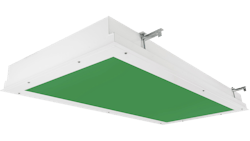Sight is a critical component of surgery. Unfortunately, the traditional supplemental surgical lighting installed in operating rooms (ORs)—the luminaires that provide general illumination, not the surgical task lights—can hinder a surgeon’s ability to see in several ways. In an attempt avoid these issues, it has become common practice in many ORs to turn off overhead lights to provide the surgeon with the best view of the procedure possible, forcing everyone else to function in the dark or improvise their own sources of illumination. It is a less than optimal solution in a truly life-and-death situation.
The crux of the problem is the use of white light, especially during a minimally invasive procedure. White overhead lights, even with the latest LEDs, are limited in their ability to provide enough ambient light for the team without compromising the quality of the image on the screen. Here are some of the common issues created by the mismatch of traditional white supplemental surgical lighting in an OR.
Common issues with white supplemental surgical light in an OR
- Reflected glare
- Washed out monitor screens
- Compromised visual acuity
- Light adaptation delay
- Eye fatigue
- Afterimage
- Overhead lights turned off
- Too little light for support staff
Luckily, this no longer needs to be the case. With advancements in LED technology, there are now supplemental surgical solutions that can provide surgeons the clear and unobstructed images they need during certain procedures, while offering surgical staff enough light to perform their jobs. This is a revolutionary idea. Operating rooms can now be equipped to offer an optimal visual environment for every procedure, which not only better accommodates the visual tasks performed in the space but allows for them to be performed with better clarity and comfort. All it requires is a little green light.
Green light interacts with a visual environment differently than white light. Instead of causing a distracting hot spot or washing out the image on a screen, the presence of ambient green lighting and its reflection off a monitor improve the depth and contrast of the image. Because green light is more screen friendly, green luminaires can be left on during a procedure, giving support staff the light they need to perform their jobs and move safely through the space. There are other benefits as well.
“The presence of green light reduces the afterimage effect experienced by surgeons and eliminates monitoring equipment glare while illuminating the space for supplemental staff,” explains John Weidner, director of engineering, Kurtzon Lighting, Chicago. “Additionally, the presence of green light in an OR avoids visual adaption delay for surgeons caused by different light levels of task and ambient lighting.”
When looking for ways to bring green LED light into an OR, there are two options: luminaires that contain white LEDs with a green lens; or luminaires that contain narrow spectrum green LEDs with a clear or frosted lens. These solutions are not considered equal.
The benefit that green lighting brings to the operating room—offering higher levels of illumination, without compromising or washing out the image on the screen during a minimally invasive procedure—is very specific to the quality of the green light. White light is so incapable of achieving these simultaneous objectives that many ORs shut off white lights completely during these procedures. This helps to explain why a more saturated green hue is preferable to one that is a watered down mixture of green light and white light.
The term saturation describes the intensity or purity of the color. As saturation increases, the color appears purer. As saturation decreases, the color appears paler or washed out. Green lighting fixtures that emit light from a narrow spectrum LED and frosted lens provide cleaner light in a more saturated green hue than the lights that emit a white light and filter it through a green lens.
White light leaks are another issue that can affect the green light emitted by the fixtures with white LEDs and green lenses. If the green lens isn’t fit correctly, if it degrades over time (most filters begin degrading as soon as the fixture is energized due to the plastic makeup of the lens and the heat from the fixture), or another circumstance occurs that compromises the lens, white light will escape the fixture and trespass into the visual environment of the OR. This mix of white light and green light will make the ambient light appear a duller green and it can impact the contrast the light provides with the image on the screen.
It is worth noting that white light leaks do not occur when the fixture only produces green light with a narrow spectrum LED.
For more information, Kurtzon Lighting developed the AIA-accredited CEU “Creating an Optimal Visual Environment in an Operating Room.” You can also email Dana Porter, director of operations at Kurtzon Lighting.
This article appeared in the November 2022 issue of Architectural SSL magazine.






